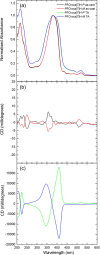500-Fold Amplification of Small Molecule Circularly Polarised Luminescence through Circularly Polarised FRET
- PMID: 33030274
- PMCID: PMC7839560
- DOI: 10.1002/anie.202011745
500-Fold Amplification of Small Molecule Circularly Polarised Luminescence through Circularly Polarised FRET
Abstract
Strongly dissymmetric circularly polarised (CP) luminescence from small organic molecules could transform a range of technologies, such as display devices. However, highly dissymmetric emission is usually not possible with small organic molecules, which typically give dissymmetric factors of photoluminescence (gPL ) less than 10-2 . Here we describe an almost 103 -fold chiroptical amplification of a π-extended superhelicene when embedded in an achiral conjugated polymer matrix. This combination increases the |gPL | of the superhelicene from approximately 3×10-4 in solution to 0.15 in a blend film in the solid-state. We propose that the amplification arises not simply through a chiral environment effect, but instead due to electrodynamic coupling between the electric and magnetic transition dipoles of the polymer donor and superhelicene acceptor, and subsequent CP Förster resonance energy transfer. We show that this amplification effect holds across several achiral polymer hosts and thus represents a simple and versatile approach to enhance the g-factors of small organic molecules.
Keywords: FRET; chirality; circular dichroism; helical structures; polymers.
© 2020 The Authors. Angewandte Chemie International Edition published by Wiley-VCH GmbH.
Conflict of interest statement
M. Fuchter is an inventor on a patent concerning chiral blend materials (WO2014016611).
Figures





References
-
- Han J., Guo S., Lu H., Liu S., Zhao Q., Huang W., Adv. Opt. Mater. 2018, 6, 1800538.
-
- Carr R., Evans N. H., Parker D., Chem. Soc. Rev. 2012, 41, 7673–7686. - PubMed
-
- Sang Y., Han J., Zhao T., Duan P., Liu M., Adv. Mater. 2020, 1900110. - PubMed
-
- Schulz M., Balzer F., Scheunemann D., Arteaga O., Lützen A., Meskers S. C. J., Schiek M., Adv. Funct. Mater. 2019, 29, 1900684.
-
- Di Nuzzo D., Kulkarni C., Zhao B., Smolinsky E., Tassinari F., Meskers S. C. J., Naaman R., Meijer E. W., Friend R. H., ACS Nano 2017, 11, 12713–12722. - PubMed
Grants and funding
LinkOut - more resources
Full Text Sources
Research Materials
Miscellaneous

